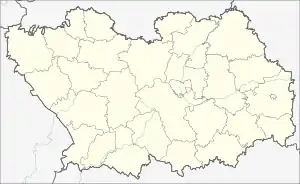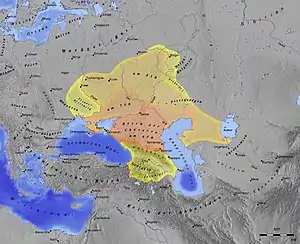ςερνια, Sernä IPA ['sʲernʲæ] | |
 Moksha lion Animal style decoration from the site. Gilded bronze. | |
 Location of the site within Russia .svg.png.webp) Sernya (European Russia) | |
| Alternative name | Russian: Золотарёвское городище, romanized: Zolotaryovskoye gorodishche |
|---|---|
| Location | Penza Oblast, Russia |
| Region | Murunza |
| Coordinates | 53°05′05″N 45°17′20″E / 53.084746°N 45.288817°E |
| Type | city |
| Area | 140,000 m2 |
| History | |
| Material | wood |
| Founded | c.200 AD |
| Abandoned | 1242 |
| Periods | Early Middle Ages |
| Cultures | Saltovo-Mayaki |
| Satellite of | Khazar Khaganate (since 8th c.) |
| Events | Mongol Destruction in 1242 |
| Site notes | |
| Excavation dates | 2000 |
| Archaeologists | Gennady Belorybkin |
| Condition | In ruins |
| Management | Penza Oblast Authority |
| Website | geosmi.ru/2022/01/19/золотарёвское-городище/ |
Sernya (Moksha: ςερνια, ςερνεσ, romanized: Sernä, Sernes, lit. 'Golden, The Golden', Russian: Золотарёвское городище, romanized: Zolotaryovskoye gorodishche, lit. 'Zolotaryovka settlement') is a site of medieval city ruins in Middle Mokshaland (modern Penza Oblast in Russia) that was razed by Mongols in 1242 battle.[1] The city was founded c. third century AD. The settlement covers 14 hectares which is comparable to the cities of the Rus' principalities in 12-13th centuries. The city fortress area is 2,5 hectares (Moscow fortress 0,8-1,5 hectare appeared in 1150s.[2])
History
The legendary Moksha city ruins were first discovered by Russian archeologist Fedor Chekalin on 22 December, 1893, but excavations started only in 2000. Askizi (Yenisei Kyrgyz) and Volga Bulgar traders stayed in the city. The city was famous for its jewelers.
Battle of Sernya

The city and its fortress were seized by Subutai in 1242 on return from the Mongol invasion of Europe as revenge to Mokshas that earlier joined the Mongol army. The Mokshan King Puresh and his men were fed up with fighting and suffered heavy losses during their European campaign.[3] They planned to shift sides and had secretly discussed with Henry II the Pious that they would join Silesian army in the early morning of 9 April 1241 before the Battle of Legnica. Subutai discovered the plot and many Moksha warriors were shot dead in their sleep while they were waiting for new weapons to come inside the Mongol camp. Defending forces used caltrops against the cavalry. Sernya's wooden walls were attacked with Chinese catapults; the Mongols used human fat for setting fire to the fortress. All defendants were killed and civilians were slaughtered during the siege. Puresh's daughter, Queen Narchat, fled with her men out of the burning fortress and headed to Noronshasht where they could hide away in Skanda caves, but they all were slain as Mongols chased them.
See also
References
- ↑ Madurov 2004, p. 264
- ↑ Chernov & Erschova 2013, pp. 387–406
- ↑ Hakluyt 1599, pp. 93–117
Notes
Sources
- Belorybkin, Gennady (2001), Zolotaryovskoye settlement (in Russian), Saint-Petersburg, Penza: PGPU
- Carpini, Giovanni; Hildinger, Erik (2014). The Story of the Mongols: Whom We Call the Tartars. Branden Books. ISBN 978-0828320177.
- Chernov, Sergey; Erschova, Ekaterina (2013). "Internal Colonization In Russia During the 13th and 14th centuries: three hamlets of the pre-manorial period". In Jan Klapste (ed.). Hierarchies in rural settlements. Ruralia. Vol. IX. Turnhout Brepols. pp. 387–406. ISBN 978-2-503-54517-2.
- Hakluyt, Richard (1599). "The iournal of frier William de Rubruquis a French man of the order of minorite friers, unto the east parts of the worlde A. Dom. 1253". The Principal Navigations Voyages Traffiques and Discoveries of the English Nation (in English and Latin). Vol. 1. London: George Bishop, Ralph Newberie, and Robert Baker. pp. 71–92 Latin text. Based on British Library MS Royal 14.C.XIII Fol. 225r-236r and thus ends prematurely.
- Madurov, Dmitry (2004), All Russia Scientific Conference. Volga Lands in History and Culture Of Russia. 13th Century Events in Moksha and Erzya History., Sernya battle in autumn 1237. Part I (in Russian), Saransk: Mordovian State University
- Schapov, V.A. (2013), Clan Symbol (in Russian), Penza
{{citation}}: CS1 maint: location missing publisher (link)
